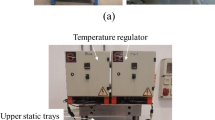The objective of this research was to optimize the process of producing nonwoven fabrics for shoe industry with good hygienic and deformation and strength properties. The task of the research was to study the influence of various types of fibrous raw materials, the content of hydrophilic fibres in the mixture and other technological parameters on the properties of nonwoven thermally bonded materials. Various fibres mixtures have been produced, deformation and strength and functional properties of nonwoven thermally bonded fabrics have been studied, optimal conditions for the production of nonwoven materials for the shoe industry have been experimentally established, mathematical dependencies of the operational properties of nonwoven shoe materials on the technological parameters of production have been determined. It has been established that depending on the material purpose and the requirements put to it, the optimal technological parameters for the production of nonwoven shoe materials are selected for the particular case in order to achieve the best quality indicators of products.




Similar content being viewed by others
References
M. Yu. Treshchalin and Yu. M. Treshchalin, “Nonwovens based on chemical fibres and short flax fibres,” Izv. VUZ. Tekhnol. Tekst. Promysh., No. 6 (384), 51-55 (2019).
V. A. Anis’kova, Yu. B. Glazova, L. A Bratchenya, and V. V. Stel’nov, “Development of technology for nonwoven footwear materials of complex structure,” in: High Technologies, Science and Education: Relevant Issues, Achievement and Innovation: Collection of Articles of the VII Russian Scientific and Practical Conference [in Russian], MTsNS Nauka i Prosveshchenie, Penza (2020).
A. D. Filippov and Yu. S. Shustov, “Comparative assessment of nonwoven materials for manufacturing shoe insoles,” in: Concepts, Theory, Methods of Fundamental and Applied Scientific Research in the Field of Inclusive Design and Technologies: Collection of Scientific Works of the International Scientific and Practical Distance Conference [in Russian], Rossiiskii Gosudarstvennyi Universitet Imeni A. N. Kosygina, Moscow (2020).
L. A. Serebryakova, I. A. Mokhireva, and S. N. Avelicheva, “Assessment of the quality and competitiveness of nonwoven shoe insole materials from secondary raw materials,” Kozhev. Obuvn. Promysh., No. 4, 36-37 (2008).
O. A. Petrova-Burkina, V. D. Borozna, et al., “Methods for assessing the properties of shoe materials,” Kompetentnost’, No. 4 (95), 48-53 (2012).
A. V. Demidov, N. V. Pereborova, et al., “System analysis methods of relaxation and recovery properties of polymer textile materials for technical purposes,” Fibre Chem., 52, No. 3, 164-167 (2020).
A. A. Makarov and V. A. Ganyavin, “Development of programming and measuring system for analysis of nonwoven textile materials,” Fibre Chem., 48, No. 5, 416-420 (2017).
A. M. Yessirkepova, G. R. Duysembekova, et al., “Modern trends and prospects for the development of global production and consumption of non-woven matreials,” Izv. VUZ. Tekhnol. Tekst. Promysh., No. 3 (387), 75-83 (2020).
B. Abzalbekuly, S. E. Munasipov, et al., “Research of structural properties of composite materials for products of light industry,” Izv. VUZ. Tekhnol. Tekst. Promysh., No. 3 (387), 66-68 (2020).
Russian Federation Patent No. 2573817 C2, IPC D04H 1/42, Nonwoven Material, Laminated Material, Product Made of Nonwoven Material, Multicomponent Fibre, Web and Method of Manufacturing Nonwoven Material [in Russian], claimed by D. D. Newkirk, J. F. Rudolf, and H. Hartl, Fitesa Germany GmbH, No. 2013122883/12 (2016).
Z. T. Bugybay, I. M. Jurinskaya, and A. N. Assanova, “Research of consumer properties of nonwoven materials from waste of wool-processing industries,” Vestn. Almatin. Tekhnol. Univ., No. 1, 10-14 (2020).
G. Gnanauthayan, R. S. Rengasamy, and V. Kothari, “Heat insulation characteristics of multi-layer nonwovens,” Res. J. Text. Apparel, 22, No. 2, 94-108 (2018).
Russian Federation Patent No. 2220241 C2, IPC D04H 1/54, A43B 17/00, Nonwoven Material for Shoe Insole and Shoe Insole Made of This Material [in Russian], claimed by L. A. Bratchenya, No. 2001128142/04 (2003).
G. L. Barabanov, E. N. Bershev, G. P. Smirnov, and Yu. Ya. Tyumenev, Physical and Mechanical Methods for the Production of Nonwoven Materials and Felts [in Russian], Legprombytizdat, Moscow (1994).
Author information
Authors and Affiliations
Corresponding author
Additional information
Translated from Khimicheskie Volokna, No. 3, pp. 47-49, May-June, 2022.
Rights and permissions
Springer Nature or its licensor (e.g. a society or other partner) holds exclusive rights to this article under a publishing agreement with the author(s) or other rightsholder(s); author self-archiving of the accepted manuscript version of this article is solely governed by the terms of such publishing agreement and applicable law.
About this article
Cite this article
Razumeev, K.E., Anis’kova, V.A., Fedorova, N.E. et al. Producing Nonwoven Materials for the Shoe Industry. Fibre Chem 54, 189–192 (2022). https://doi.org/10.1007/s10692-022-10373-8
Published:
Issue Date:
DOI: https://doi.org/10.1007/s10692-022-10373-8




